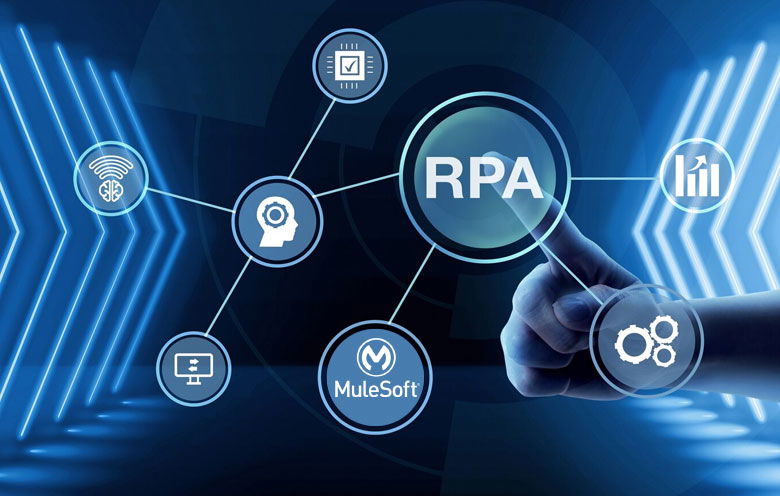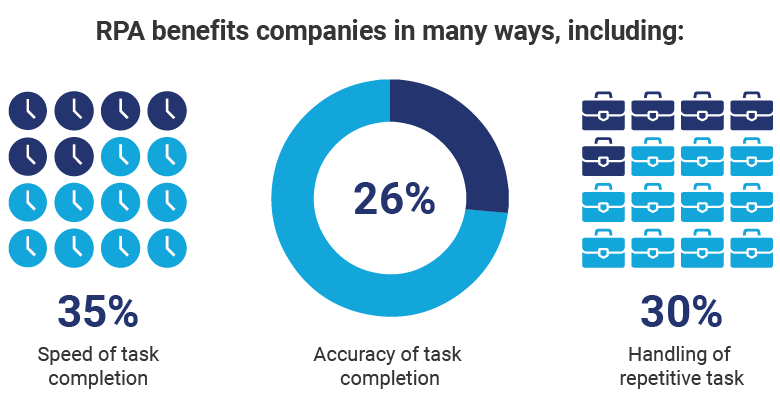Modern businesses often face challenges, such as process inefficiencies, escalating operational costs, and stringent compliance requirements. These challenges often stem from fragmented systems and manual workflows that hinder agility and accuracy. Intelligent automation is the answer to addressing these issues.
MuleSoft RPA is a transformative solution that combines the power of robotic process automation (RPA) with MuleSoft’s robust integration capabilities. This powerful combination helps companies address such challenges by:
- Automating repetitive tasks
- Automating rule-based tasks
- Ensuring seamless data flow
- Orchestrating complex workflows across heterogeneous systems
Source: Robocorp
In this blog, we will discuss how MuleSoft RPA integration services can automate repetitive tasks. We will also explore its benefits and use cases.
What is MuleSoft RPA?
MuleSoft RPA is a software platform that uses software bots to automate manual tasks and business processes. It empowers you to:
- Connect disparate systems: Eliminate data silos by seamlessly integrating with various applications, databases, and legacy systems.
- Extract data from anywhere: Extract and manipulate data from web interfaces, PDFs, and other unstructured sources.
- Orchestrate complex workflow: Build multi-step automations that combine RPA actions with API calls and data transformations. This enables you to automate entire end-to-end processes.
Benefits of MuleSoft RPA integration
Enhanced operational efficiency
MuleSoft RPA eliminates repetitive and mundane tasks. This allows your employees to focus on critical tasks, significantly improving overall productivity and operational efficiency.
Accuracy and consistency
Mitigate the risks of human errors to ensure consistent and precise execution of processes. This is particularly critical for tasks requiring high accuracy, such as data entry and transaction processing.
Cost optimization
You can significantly reduce operational costs by reducing manual tasks. MuleSoft RPA also minimizes the demand for extensive IT resources for maintenance and support.
Scalability
MuleSoft RPA scales seamlessly with the growing business demands. Whether you see increased transaction volumes or expand to new operational areas, MuleSoft RPA scales automation efforts effectively.
Regulatory compliance
MuleSoft RPA ensures that processes comply with regulatory requirements by automating compliance checks and data handling protocols.
Automate data entry
Automated data entry offers a convenient solution for seamless integration with older systems, relieving you of manual efforts while enhancing accuracy.
Smart data extraction
AI-powered tools enable you to quickly extract relevant information from PDFs, emails, and documents. This accelerates the process efficiency.
Text recognition with OCR
OCR technology simplifies the process of recognizing and extracting images and scanned documents, making it easy and user-friendly.
Workflow automation
Automate workflows like data copying, validating, and sending notifications. It minimizes errors while ensuring consistency.
What are the key components of MuleSoft RPA?
- MuleSoft RPA Builder: It is a visual design tool that enables you to create and configure RPA bots. You can define their workflows and set up automation tasks.
- MuleSoft RPA Manager: It is a centralized control interface. It enables deploying, managing, and monitoring RPA bots across the organization. It ensures efficient bot operation and provides detailed analytics and reporting.
- MuleSoft RPA Recorder: It is a tool that captures and records user actions on applications and systems, which can be used to train and configure RPA bots to replicate these actions.
Unified Platform for MuleSoft RPA Lifecycle
With MuleSoft RPA, businesses can efficiently manage the entire RPA lifecycle from a single, unified platform.
Key use cases for MuleSoft RPA
| Industry | Process | Description |
| Financial services | Account reconciliation | Compare account statements from different sources and identify discrepancies, saving manual effort. |
| Loan processing | Automate data entry and document verification for faster loan approvals. | |
| Regulatory compliance | Generate reports and extract data for audits and regulatory filings. | |
| Healthcare | Insurance claim processing | Automate data extraction from medical records and submit claims electronically. |
| Patient appointment scheduling | Manage appointments across different calendars and send automated reminders. | |
| Medical record management | Extract and organize patient data from various sources into a centralized system. | |
| Manufacturing | Order processing | Automate order fulfillment by processing orders from different channels and updating inventory levels. |
| Production planning | Automate data collection from machines and sensors to optimize production schedules. | |
| Supply chain management | Automate communication with suppliers and track deliveries. | |
| Retail | New account creation | Automate account creation across various systems (CRM, loyalty program) based on customer information |
| Order fulfillment | Automate order processing, picking, and packing for faster delivery. | |
| Customer service | Automate responses to frequently asked questions and handle simple customer inquiries. |
Suggested: What is the role of API integration in the finance industry?
What are the steps to implement MuleSoft RPA?
Initial assessment and planning:
Step: Conduct a comprehensive assessment of your current processes and identify areas where automation can deliver the most significant benefits. Develop a clear automation strategy aligned with your business objectives.
Outcome: A strategic roadmap for RPA implementation, highlighting high-priority processes for automation.
Process identification and documentation:
Step: Identify specific processes suitable for automation and document the workflows, including input data, business rules, and expected outputs.
Outcome: Detailed process documentation, ensuring a clear understanding of the tasks to be automated.
Tool selection and RPA design:
Step: Select the appropriate MuleSoft RPA components and design the automation solution. This includes configuring bots, setting up triggers, and defining the workflow sequences using MuleSoft’s Anypoint Platform.
Outcome: A well-designed RPA workflow ready for development.
Bot development and testing:
Step: Develop the RPA bots using MuleSoft RPA Builder and Recorder. Test the bots rigorously in a controlled environment to ensure they function correctly and meet the defined requirements.
Outcome: Fully developed and tested RPA bots ready for deployment.
Integration with existing systems:
Step: Integrate the RPA solution with existing systems and applications using MuleSoft’s integration capabilities. Ensure seamless data flow and interoperability across the enterprise.
Outcome: Integrated RPA solution, enabling automated workflows across multiple systems.
Deployment and monitoring:
Step: Deploy the RPA bots into the production environment and continuously monitor their performance using MuleSoft RPA Manager. Track bot activity, identify potential issues, and ensure optimal performance.
Outcome: Deployed and monitored RPA bots, ensuring smooth and efficient operation.
Continuous improvement and scaling:
Step: Regularly review and optimize the automated processes. Identify opportunities for further automation and scale the RPA solution to additional processes and departments as needed.
Outcome: Continuous improvement of automated workflows and scalable RPA solution.
Challenges and solutions of MuleSoft RPA integration
Integration complexity
- Challenge: Integrating diverse systems and applications can be complex and time-consuming.
- Solution: MuleSoft’s robust integration capabilities streamline the process of connecting disparate systems. This enables seamless automation.
Change management
- Challenge: Implementing RPA necessitates changes to existing workflows and employee roles, potentially facing resistance.
- Solution: Effective change management strategies, including comprehensive training and clear communication, can facilitate a smooth transition to automated processes.
Security concerns
- Challenge: There are several security risks with automation, such as unauthorized access and data breaches.
- Solution: Implementing stringent security measures, including role-based access controls and encryption, can mitigate these risks.
Scalability
- Challenge: Scaling RPA integration efforts across the organization can be challenging.
- Solution: MuleSoft’s scalable architecture supports the expansion of automation initiatives, ensuring consistent performance.
Maintenance and support
- Challenge: Ongoing maintenance and support of RPA solutions can be resource intensive.
- Solution: Leveraging MuleSoft’s support services and best practices can help maintain the efficiency and reliability of automated processes.
Leverage the benefits of integrating RPA with MuleSoft RPA
If you are looking to enhance efficiency, accuracy, and agility, MuleSoft RPA integration is the key. By integrating MuleSoft’s advanced platform capabilities with RPA, organizations can automate a wide array of processes, driving significant improvements in productivity and cost savings. While challenges exist, strategic solutions and best practices can help organizations overcome these hurdles and unlock the full potential of MuleSoft RPA.
Contact Softweb Solutions today to discover how our expertise in MuleSoft RPA integration can revolutionize your processes and drive unparalleled efficiency.






